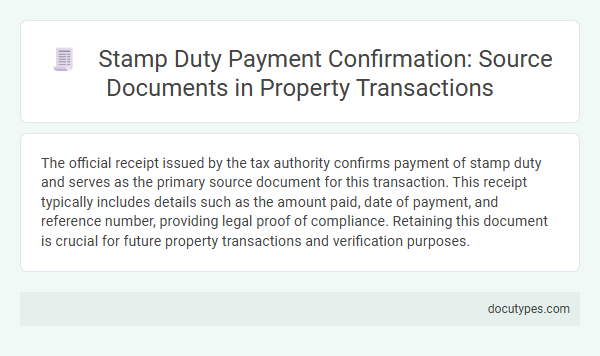The official receipt issued by the tax authority confirms payment of stamp duty and serves as the primary source document for this transaction. This receipt typically includes details such as the amount paid, date of payment, and reference number, providing legal proof of compliance. Retaining this document is crucial for future property transactions and verification purposes.
Introduction to Stamp Duty in Property Transactions
Stamp duty is a tax levied on property transactions, crucial for legal ownership transfer. Understanding the source document that confirms payment helps ensure compliance and avoid legal issues.
- Stamp Duty Receipt - The official document issued by the tax authority confirming your payment of stamp duty.
- Stamp Certificate - A legal certificate provided after payment, serving as proof for property registration purposes.
- Payment Challan - A transaction receipt generated during the online or offline payment of stamp duty.
Keeping these documents safe validates your stamp duty payment in property dealings.
Importance of Stamp Duty Payment Confirmation
Stamp duty payment confirmation is typically verified through the stamp duty receipt or challan issued by the relevant government authority. This source document serves as legal proof that the required stamp duty has been paid for a property transaction.
Confirming stamp duty payment is crucial as it validates the authenticity of the property transfer and protects against future legal disputes. Proper documentation ensures compliance with tax regulations and facilitates smooth registration of the property deed.
Key Source Documents for Stamp Duty Verification
Confirming payment of stamp duty is essential in property transactions to ensure legal compliance. Key source documents serve as official proof of your stamp duty payment.
- Stamp Duty Receipt - This official receipt issued by the tax authority confirms the actual payment of stamp duty on the property transaction.
- Stamp Duty Certificate - A certificate provided by the government or relevant authority that verifies stamp duty has been duly paid and recorded.
- Property Transfer Document - This document often includes a stamp or annotation evidencing the stamp duty payment linked to the transfer of property ownership.
Stamp Duty Certificate: What It Is and Why It Matters
The source document that confirms payment of stamp duty is the Stamp Duty Certificate. This certificate serves as legal proof that the required stamp duty on a property transaction has been paid. Your possession of this document ensures compliance with government regulations and validates the transaction's authenticity.
Role of Payment Receipts in Stamp Duty Confirmation
Payment receipts serve as the primary source document confirming the payment of stamp duty in property transactions. These receipts provide official evidence that the required tax has been settled with the relevant authority.
- Payment Receipt as Proof - A receipt issued by the stamp duty office or authorized bank validates the exact amount paid for the stamp duty.
- Legal Recognition - The payment receipt acts as a legally recognized document during property registration and dispute resolution.
- Your Confirmation - Keeping your payment receipt ensures you can verify and prove the fulfillment of your stamp duty obligations when needed.
Utilizing Bank Statements as Supporting Evidence
The primary source document that confirms payment of stamp duty in property transactions is the official receipt issued by the tax authority or government agency responsible for collecting stamp duty. This receipt serves as legal proof that the required duty has been paid.
Bank statements can be utilized as supporting evidence to verify the payment of stamp duty, especially when the official receipt is unavailable or needs corroboration. These statements provide a detailed record of the transaction, showing the date, amount, and recipient of the payment. Using bank statements helps establish a clear financial trail linked to the stamp duty payment in property deals.
Common Challenges in Obtaining Stamp Duty Documents
The primary source document confirming the payment of stamp duty is the stamped receipt or certificate issued by the tax authority upon transaction completion. This document serves as legal proof that the required stamp duty has been paid and is essential for property registration and transfer processes.
Common challenges in obtaining stamp duty documents include delays caused by administrative backlogs and discrepancies in payment records. You may also encounter difficulties when documents are misplaced or when dealing with outdated or unclear procedural requirements from local authorities.
Legal Implications of Missing Stamp Duty Confirmation
The source document that confirms payment of stamp duty is the stamped deed or the official stamp duty receipt issued by the tax authority. This document serves as legal proof that the required stamp duty has been paid for a property transaction. Missing confirmation of stamp duty payment can lead to legal complications, including invalidation of the property transfer and potential penalties.
Best Practices for Safekeeping Stamp Duty Documentation
| Source Document Confirming Payment of Stamp Duty | The official Stamp Duty Receipt issued by the relevant government authority serves as the primary source document confirming the payment of stamp duty. This document includes details such as the transaction reference number, payment date, amount paid, and the property identification information. |
|---|---|
| Best Practices for Safekeeping Stamp Duty Documentation |
|
What Source Document Confirms Payment of Stamp Duty? Infographic

